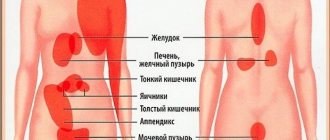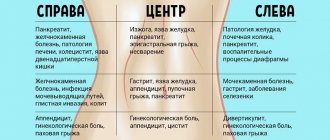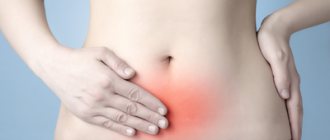Abdominal pain is one of the most common types of pain, which can occur in isolation or be part of pathological symptoms in some diseases. Pain can occur on the sides, in the lower abdomen, in the epigastric and abdominal areas. Pain in the peri-umbilical region is less common: below, at the top, on the left side or to the right of the navel. The greatest danger is pain in the right side near the umbilical area, since this symptom may indicate serious illnesses, for example, inflammation of the appendix.
Abdominal pain to the right of the navel
Possible reasons
In the right quadrant of the abdomen there are parts of the intestine (the hepatic angle of the colon in the right hypochondrium, the ascending colon on the right flank, the cecum with the vermiform appendix in the right iliac region), the small intestine occupies the entire umbilical region, the appendix. The internal organs of the reproductive system - the uterine appendages - occupy the right and left iliac, possibly also suprapubic, regions. Therefore, pain in the right side of the abdomen is most often caused by disturbances in the functioning of these organs.
Possible causes of pain in the navel area
Intestinal problems
About 50% of pathologies in which the patient complains of pain to the right of the navel are associated with the functioning of the intestines. These may be the following diseases:
- irritable bowel syndrome is a functional intestinal disorder that has periods of remission and exacerbation and a chronic course (the diagnosis is made if intestinal function is disrupted for three months in a row, and there are no infectious or organic causes);
- intestinal obstruction - a condition in which the movement of food through the digestive tract is disrupted and the motor activity of the intestinal walls stops;
- colitis – inflammation of the outer epithelial layer of the intestinal walls;
- diverticulitis is an inflammatory process in the intestines, in which protrusions in the form of pouches, reminiscent of hernias, form in its cavity;
- Enteritis is a disease characterized by impaired absorption of nutrients by the walls of the small intestine and atrophy of the cell layer of the mucous membranes.
What can be dangerous about pain in the navel area?
Errors in nutrition, high levels of salt and chemical additives in the diet, disruption of the intestinal microflora, smoking and ethanol abuse can also trigger the appearance of pain on the right side of the umbilical region. If the patient has recently been treated with antibiotics and other drugs with high antibacterial activity, discomfort may be an adverse reaction to treatment.
Note! In women who often go on diets and limit their diet, such pain can be chronic. To prevent this, you need to take a responsible approach to diet planning. The daily menu must include meat and poultry (preferably farmed), fish, chicken or quail eggs, fruits, herbs, nuts, milk and berries.
Circulatory disorders
Location of organs in the abdominal cavity
Impaired blood circulation can also lead to moderate pain to the right of the navel. Most often this occurs when the mesenteric vessels are compressed. The mesentery is a type of ligament that connects the back of the abdominal cavity to various parts of the intestinal tube. Thanks to this fold, the intestines take a vertical position rather than sinking into the lower abdomen. If the movement of blood through the vessels covering the surface of the mesentery is impaired, the person experiences a stabbing pain of moderate intensity. At the same time, other symptoms may occur:
- pain in the intestinal area;
- difficulty with bowel movements;
- stool instability.
Pathology can be detected using ultrasound diagnostics.
Appendicitis
Signs of appendicitis
Appendicitis can be suspected if the patient complains of pain on the right side of the navel, which intensifies when changing body position and does not go away within 12 hours. Appendicitis is a severe surgical pathology in which inflammation of the appendix (the vermiform appendix, which is an appendage of the cecum) occurs. Appendicitis has quite bright and pronounced symptoms, but most of the symptoms cannot be called specific and characteristic of this disease. For this reason, doctors prohibit giving the patient any medications (especially painkillers) until the person is examined. The use of any medications can “blur” the clinical picture of the pathology and make it difficult to make an accurate diagnosis.
Video: How to distinguish appendicitis from other abdominal pain
Symptoms of acute appendicitis include:
- rapid development of hypotension (including isolated decrease in blood pressure);
- headache;
- vomiting (most often one-time) and severe nausea;
- pain on the right side of the abdomen, which can occur near the navel, in the central part, and then become diffuse;
- cold sweat;
- abdominal muscle tension.
Appendectomy
Important! Treatment for appendicitis is always surgical. If the inflamed appendix is not removed in time, purulent exudate can enter the abdominal cavity and bloodstream, which will lead to the development of peritonitis (inflammation of the organs and tissues of the peritoneum) and sepsis.
Intestinal hernia
Hernial protrusion is another possible cause of chronic pain in the umbilical ring area. Depending on the location, pain may occur on the right or left side. A hernia is a protrusion of the intestine that extends beyond its location while maintaining the integrity of the mucous membranes lining the inner surface of the intestine.
In some cases, pain can be caused by an umbilical ring hernia, but this pathology in adults is extremely rare, since in most cases it is diagnosed and operated on in childhood (up to 5-7 years).
Intestinal hernia
Other reasons
This symptom can occur with diseases of the kidneys, pancreas, and gallbladder. With cholecystitis (inflammation of the gallbladder), tingling pain on the right side of the navel is one of the first symptoms of the pathology, after which other characteristic signs begin to develop. To the list of diseases in which you may experience right-sided pain around the navel, you can add the following pathologies:
- ulcerative damage to the walls of the intestines or stomach;
- formation of stones in the gall bladder (cholelithiasis);
- liver diseases;
- pathologies in the functioning of the diaphragm.
Abdominal pain
Important! Malignant lesions of the small intestine may also have tenderness to the right of the navel as one of the symptoms. The pain is nagging, aching, chronic in nature and intensifies when pressing on the umbilical ring. To exclude the possibility of cancer, you need to contact an oncologist.
Video - Why does the right lower abdomen hurt?
Causes of abdominal pain to the right of the navel
To the right of the navel are the following organs:
- angle of the colon;
- part of the small intestine;
- ureters;
- gallbladder;
- vermiform appendix - appendix.
Half of all cases of pain to the right of the umbilical fossa are various intestinal disorders. These include infections, functional problems, tissue damage or inflammatory processes.
Enteritis
The disease is otherwise called intestinal flu. Transmitted through direct contact, dirty hands. If one family member gets sick, everyone soon becomes infected. The acute phase can last about a week, then all symptoms - abdominal pain, watery diarrhea, vomiting - go away. A person remains infectious for some time - from 10 to 21.
If blood impurities appear in the stool, most likely the nature of the enteritis is not viral; you need to check the condition of the intestines in the hospital using an ultrasound.
Elderly people and patients with weakened immune systems are more susceptible to viral infection. Fatalities are common.
Intestinal obstruction
It can occur without obvious reasons, especially in people who have previously undergone abdominal surgery - adhesions after inflammation can pull on any part of the intestine - large or small. The condition is dangerous and requires urgent surgical treatment. In case of delay, tissue rupture and release of feces into the abdominal cavity with subsequent development of peritonitis is possible.
Irritable bowel syndrome
The disease is more common in women. Risk factors:
- diet;
- irregular meals;
- fast food;
- stressful situations.
Irritable bowel syndrome occurs in a chronic form. Remissions followed by exacerbation are possible.
Diverticulitis
The onset of the disease can occur at any age, most often in the elderly. Diverticula are pouch-shaped protrusions in the large intestine. Promote their appearance:
- flatulence;
- constipation with the formation of fecal stones;
- obesity;
- eating predominantly meat.
If you do not get help in time, wall rupture, intestinal bleeding and peritonitis are possible.
Exacerbation of peptic ulcer
The disease is characterized by periodic remissions and exacerbations. Untreated gastritis often causes damage to the mucous membrane of the stomach and duodenum. Severe pain occurs when the ulcer perforates and internal bleeding begins.
The most common cause of peptic ulcers is poor diet or the bacterium Helicobacter pylori. You may vomit blood or dark stool. In this case, the person is urgently taken to surgery and surgery is performed.
Presence of kidney stones
When a stone passes through the ureter on the right, a sharp unbearable pain occurs, during which it is impossible to take any comfortable position. A team of doctors should be called to administer painkillers and agents that dilate and lubricate the inner wall of the ureter, for example, glycerin. Stones that are larger than 5 mm in diameter are dangerous, as they can completely block the passage for urine, thereby causing an increase in the size of the renal pelvis. Prolonged presence of the stone leads to the appearance of a bedsore on the wall of the ureter, then its perforation and necrosis.
The cause of pain in the right side may be pyelonephritis or cystitis. The condition is dangerous due to duct obstruction, when urine stops leaving the kidney and irritates the walls of the ureter and pelvis.
Appendicitis
Inflammation of the cecum causes acute pain. If you press down on the stomach and suddenly release it, the person will feel a sharp pain and scream. This means he needs to be taken to the hospital for surgery.
Delay can cost life, since necrotic changes in tissues cause their rupture, followed by the outpouring of pus into the abdominal cavity, after which the person begins to have peritonitis and requires not just an operation, but a complete rinsing of the abdominal cavity with a disinfectant solution, placement of a catheter and long-term rehabilitation.
In men, pain to the right of the umbilical fossa is most often caused by inflammation of the prostate. The cause of prostatitis is urinary tract infection. The first symptom that indicates the onset of inflammation is a deterioration in the outflow of urine and incomplete emptying of the bladder, which leads to frequent urge to go to the toilet.
Women's diseases
The cause of abdominal pain to the right of the navel in women can be an inflammatory process in the appendages due to hypothermia. Other possible pathologies:
- benign tumors of the uterus;
- cervical erosion;
- endometriosis;
- malignant ovarian tumors;
- ovarian rupture.
Sharp painful sensations require urgent diagnosis and treatment.
Causes of pain in women
In women, this type of pain may indicate gynecological diseases and inflammatory processes in the genitourinary system. The most common of them is endometrial pathology. endometriosis to be a chronic disease that cannot be cured completely, but the pathological growth and division of connective tissue cells can be stopped. The disease is characterized by the growth of the inner layer of the uterus beyond the organ.
Endometriosis
Doctors believe that the main reason for the development of endometriosis is hormonal disorders, which most girls develop during puberty.
Another hormonal pathology is endometrial hyperplasia . With this disease, pathological growth of the endometrium and its thickening occurs. The symptoms of the disease are quite characteristic, so diagnosis usually does not cause difficulties.
What is endometrial hyperplasia
Signs of endometrial hyperplasia include:
- uterine bleeding that lasts more than 7-10 days;
- pain in the lower abdomen and umbilical area on the right side or below;
- temperature rise to 37.8-38.3°;
- pale skin;
- signs of anemia;
- headache and dizziness;
- decreased blood pressure;
- weakness and decreased performance.
In most cases, it is possible to stop bleeding during the disease only with the help of curettage, which can be used for diagnostic purposes. Using a special surgical instrument (curette) or vacuum, the doctor removes the entire endometrium and sends the resulting material for histological examination.
Causes of cystitis
Moderate nagging pain to the right of the umbilical ring can also be caused by the following diseases:
- myoma or fibroid of the uterus;
- cystitis;
- pyelonephritis;
- inflammation of the ovaries or appendages;
- glomerulonephritis;
- cervical erosion.
Note! If after treatment of the underlying disease the pain does not go away or intensifies, you should consult an oncologist to exclude the possibility of cancer of the female genital area.
Causes of cramping pain to the right of the umbilical ring
The pain is not always pulling, cutting or stabbing in nature. In some diseases, it can resemble muscle spasms, which are most often the result of narrowing of the intestinal walls.
Crohn's disease
This symptom appears in the following pathologies:
- formation of adhesions in the intestines;
- Crohn's disease is a chronic pathology in which granulomatous inflammation of certain areas of the gastrointestinal tract occurs;
- ulcerative colitis of a nonspecific type with signs of scarring;
- megacolon - expansion and thickening of the walls of the colon.
Bloating, flatulence and other dyspeptic disorders, which are most often the result of overeating and disorders of the digestive system, can also cause cramping pain, which goes away after the negative factor is eliminated.
Symptoms of Crohn's disease
Why does pain appear to the right of the navel in men?
The most likely cause of this symptom in men of any age is prostatitis . This is an inflammatory process that affects prostate tissue, which can have non-infectious and infectious etiologies. Prostatitis most often takes a chronic course with periods of exacerbation.
Signs of prostatitis
Symptoms of the disease are usually:
- pain during urination and sexual intercourse;
- swelling and swelling of prostate tissue;
- temperature rise to low-grade levels;
- frequent urge to empty the bladder.
Simultaneously with prostatitis, another pathology of the prostate gland often occurs - prostate adenoma. In uncomplicated cases, treatment of the pathology can be conservative. In more severe cases, surgical therapy will be required.
Causes of pain on the right side of the abdomen
Tingling Treatment Methods
Tingling in the navel area can only be treated with medications prescribed by the doctor. It is also important to first identify the problem causing the symptom. If a symptom appears for the first time and only bothers you for a few hours, you should not pay attention to it. If it occurs regularly, then diagnosis cannot be avoided.
Depending on the identified problem, the doctor may prescribe:
- medications to correct the problem, including drugs for the heart, intestines or stomach, antibiotics and specific substances;
- surgical intervention for coronary heart disease and other serious pathologies;
- physiotherapeutic procedures for chronic diseases;
- a balanced diet if there is damage to the intestines, bladder or kidneys.
The nature of therapy largely depends on the accompanying symptoms and the complexity of the underlying disease.
Diagnostics: who to contact if there is pain to the right of the navel?
If such a symptom appears, it is necessary, especially if it has a chronic course and high intensity, you must contact the following specialists:
- gastroenterologist;
- proctologist;
- surgeon;
- oncologist;
- gynecologist (for women).
If the patient does not have other symptoms characteristic of certain diseases, the examination can begin with a consultation with a therapist, who will conduct a visual examination, palpation of the abdominal area, and collect a medical history.
If you have abdominal pain, consult a doctor
Based on the results of the initial examination, the patient will be prescribed additional examination methods listed in the table below.
| Diagnostic method | Efficiency and accuracy of the result obtained |
| Ultrasound of the abdominal organs | 80-85 % |
| Abdominal x-ray | ≥ 92 % |
| MRI | ≥ 94 % |
| Biochemical examination of blood and urine | 98-100 % |
| Analysis for tumor markers (if malignant processes are suspected) | 98-100 % |
| Biopsy, colposcopy (for women) | ≥ 95 % |
Video - Possible causes of abdominal pain
Necessary diagnostics
If pain persists for a long time or is intense, you should consult a doctor. To identify the cause of pain in the umbilical area, it is necessary to carry out a number of diagnostic measures. Research allows us to determine the localization of the pathology and its etiology. Specialists prescribe the following procedures to the patient:
- Ultrasound of the kidneys and abdominal organs;
- FGDS;
- general stool analysis, occult blood test;
- clinical urine analysis;
- General and biochemical blood test.
Depending on the nature of the identified pathology, the patient is prescribed a consultation with a gastroenterologist, nephrologist, gynecologist or infectious disease specialist.











